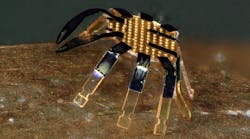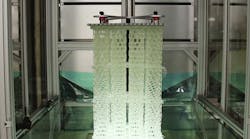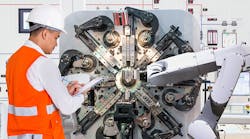Tiny Robotic Crab: An Answer for Automation in Tight Spaces?
Engineers at Northwestern University have developed the smallest-ever remote-controlled walking robot—and it comes in the form of a peekytoe crab.
Just a half-millimeter wide, the tiny crabs can bend, twist, crawl, walk, turn, and even jump. The researchers also developed millimeter-sized robots resembling inchworms, crickets, and beetles.
Although the research is exploratory at this point, the researchers believe their technology might bring the field closer to realizing micro-sized robots that can perform practical tasks inside tightly confined spaces.
The research was published on May 25, 2022, in the journal Science Robotics. Last September, the same team introduced a winged microchip that was the smallest-ever human-made flying structure (published on the cover of Nature).
“Robotics is an exciting field of research, and the development of microscale robots is a fun topic for academic exploration,” said John A. Rogers, who led the experimental work.
“You might imagine micro-robots as agents to repair or assemble small structures or machines in industry or as surgical assistants to clear clogged arteries, to stop internal bleeding or to eliminate cancerous tumors—all in minimally invasive procedures.”
To manufacture such a tiny critter, Rogers and Huang turned to a technique they introduced eight years ago—a pop-up assembly method inspired by a child’s pop-up book.
“Our technology enables a variety of controlled motion modalities and can walk with an average speed of half its body length per second,” added Yonggang Huang, who led the theoretical work. “This is very challenging to achieve at such small scales for terrestrial robots.”
A pioneer in bioelectronics, Rogers is the Louis Simpson and Kimberly Querrey Professor of Materials Science and Engineering, Biomedical Engineering, and Neurological Surgery at Northwestern’s McCormick School of Engineering and Feinberg School of Medicine and the director of the Querrey Simpson Institute for Bioelectronics (QSIB). Huang is the Jan and Marcia Achenbach Professor of Mechanical Engineering and Civil and Environmental Engineering at McCormick and a key member of QSIB.
Smaller than a flea, the crab is not powered by complex hardware, hydraulics or electricity. Instead, its power lies within the elastic resilience of its body. To construct the robot, the researchers used a shape-memory alloy material that transforms to its “remembered” shape when heated. In this case, the researchers used a scanned laser beam to rapidly heat the robot at different targeted locations across its body. A thin coating of glass elastically returns that corresponding part of the structure to its deformed shape upon cooling.
As the robot changes from one phase to another—deformed to remembered shape and back again—it creates locomotion. Not only does the laser remotely control the robot to activate it, but the laser scanning direction also determines the robot’s walking direction. Scanning from left to right, for example, causes the robot to move from right to left.
“Because these structures are so tiny, the rate of cooling is very fast,” Rogers explained. “In fact, reducing the sizes of these robots allows them to run faster.”
First, the team fabricated precursors to the walking crab structures in flat, planar geometries. Then, they bonded these precursors onto a slightly stretched rubber substrate. When the stretched substrate is relaxed, a controlled buckling process occurs that causes the crab to “pop up” into precisely defined three-dimensional forms.
With this manufacturing method, the Northwestern team could develop robots of various shapes and sizes.
So why a peekytoe crab? We can thank Rogers’ and Huang’s students for that.
“With these assembly techniques and materials concepts, we can build walking robots with almost any size or 3D shapes,” Rogers said. “But the students felt inspired and amused by the sideways crawling motions of tiny crabs. It was a creative whim.”















